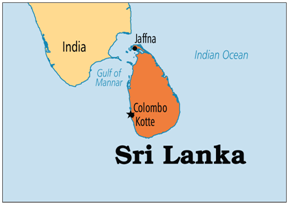Economy
Loan to Sri Lanka for Solar Energy
- 17 Jun 2021
- 5 min read
Why in News
Recently, India has signed an agreement extending a USD 100 million Line of Credit (LOC) to Sri Lanka for projects in the Solar Energy Sector. The LOC is for a period of 20 years, with an interest of 1.75%.
- The agreement was signed between the Government of Sri Lanka and the Export-Import (EXIM) Bank of India.
- EXIM Bank is a specialized financial institution, wholly owned by the Government of India.
Line of Credit
- It is a credit facility extended by a bank or any other financial institution to a government, business or an individual customer, that enables the customer to draw the maximum loan amount.
- The borrower can access funds from the line of credit at any time as long as they do not exceed the maximum amount (or credit limit) set in the agreement and meet any other requirements such as making timely minimum payments.
Key Points
- Significance of the LOC:
- It will help finance various projects in the solar energy sector in Sri Lanka, such as rooftop solar photo-voltaic systems for households and government buildings.
- Some of these projects were announced during the Founding Conference of the International Solar Alliance (ISA) held in March 2018 in Delhi.
- It will help finance various projects in the solar energy sector in Sri Lanka, such as rooftop solar photo-voltaic systems for households and government buildings.
- India’s Initiatives for Global Cooperation Solar Energy:
- International Solar Alliance (ISA):
- The ISA was launched by the Prime Minister of India and the President of France in 2015 on the side-lines of the United Nations Climate Change Conference of the Parties (COP-21), with 121 solar resource rich countries lying fully or partially between the tropic of Cancer and tropic of Capricorn as prospective members.
- 89 countries have signed the ISA framework agreement.
- ISA’ vision is to enable One World, One Sun, One Grid (OSOWOG).
- One Sun, One World, One Grid (OSOWOG):
- It focuses on a framework for facilitating global cooperation, building a global ecosystem of interconnected renewable energy resources (mainly solar energy) that can be seamlessly shared.
- International Solar Alliance (ISA):
- Schemes for Promoting Solar Energy in India: Recently, India achieved 5th global position in solar power deployment by surpassing Italy.
- National Solar Mission (a part of National Action Plan on Climate Change): The aim is to establish India as a global leader in solar energy by creating the policy conditions for its deployment across the country.
- Rooftop Solar Scheme: To generate solar power by installing solar panels on the roof of the houses, the Ministry of New and Renewable Energy is implementing Grid-connected Rooftop Solar Scheme (Phase II).
- Production-linked Incentive (PLI) scheme to promote manufacturing of high efficiency solar PV modules in India.
- Scheme for Development of Ultra Mega Renewable Energy Power Parks: It is a scheme to develop Ultra Mega Renewable Energy Power Parks (UMREPPs) under the existing Solar Park Scheme.
- Kisan Urja Suraksha evam Utthaan Mahabhiyan (PM-KUSUM): The scheme covers grid-connected Renewable Energy power plants (0.5 – 2 MW)/Solar water pumps/grid connected agriculture pumps.
- National Wind-Solar Hybrid Policy, 2018: its main objective is to provide a framework for promotion of large grid connected wind-solar PV hybrid systems for optimal and efficient utilization of wind and solar resources, transmission infrastructure and land.
- Atal Jyoti Yojana (AJAY): It was launched in September 2016 for the installation of solar street lighting (SSL) systems in states with less than 50% households covered with grid power (as per Census 2011).
- Suryamitra Skill Development Programme: To provide skill training to rural youth in handling solar installations.






-min.jpg)